|
Battle of Oak Hill
Battle of Gettysburg
| Oak Hill from the west |

|
| Oak Hill, Battle of Gettysburg |
Battle of Oak Hill and Gettysburg
Oak Hill was an important position for the Confederates on July 1st. The gentle slope of this hill and open
terrain to the south offered an excellent field of fire for artillery that could send shells into the Union positions at the
McPherson Farm and Seminary Ridge, with little opportunity for the Union gunners to reply. A part of the John Forney Farm, Oak Hill rises just north of the
Mummasburg Road and in 1863 had an expansive apple orchard on its southern slope. Some time after noon, the Confederate infantry
division of Major General Robert E. Rodes (killed-in-action at Third Winchester in 1864) arrived and deployed behind the hill, using trees to screen their movement from Union observers. Having
received word that troops from A.P. Hill's Corps were going to attack at 1 P.M., Rodes moved his infantry southward to attack
from this hill and threaten the Union forces in positions on the McPherson Farm and Oak Ridge.
| Gen. Robert Rodes |

|
| Miller's History |
Confederate gunners set up their
artillery pieces amongst the fruit-laden trees of Forney's orchard and opened fire on the Union positions approximately one-half
mile to the south once the infantry had passed through. Rodes watched his formations go forward. "(The enemy) had apparently
been surprised;" Rodes reported, "only a desultory fire of artillery was going on between his troops and General Hill's; but
before my dispositions were made, the enemy began to show large bodies of men in front of the town." Seeing Union troops move
up the ridge toward Oak Hill, Rodes quickly ordered three of his brigades to attack. But the movement was uncoordinated and
two of his brigades faltered when they encountered stiff Union resistance, heavy artillery fire, and unforeseen obstacles.
| View south from Oak Hill toward the McPherson Farm |
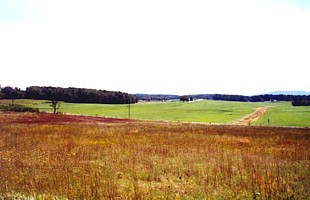
|
| Gettysburg NMP |
Brig. Gen. Alfred Iverson's Brigade of North Carolina troops set off to strike the flank of Union positions
located on Oak Ridge, the northern extension of Seminary Ridge and southwest of this hill. The Carolinians moved southeast
toward Oak Ridge in perfect alignment with flags swaying, closing on the suspected Union line without actually seeing the
Union positions. Suddenly a host of Union soldiers, the regiments of Brig. General Baxter's brigade, rose from behind a stone
wall on the ridge and loosed a volley into the Confederate ranks, knocking down scores of men and officers and stopping the
brigade in its tracks. For the survivors of the initial volley, the ensuing fifteen minutes were filled with horror. Every
musket shot aimed toward the Union line was answered by a storm of musketry. A number of soldiers in one regiment were able
to evade the deadly fire by taking cover behind a slight rise of ground, but the others were frozen as if locked in place
while Union fire unmercifully rained down on them.
| Iverson's troops were trapped by Union fire here |
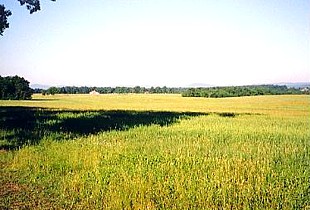
|
| Gettysburg NMP |
Captain Lewis Hicks of the 20th North Carolina recalled, "We carried three
hundred (soldiers) in(to) action. (The) result of two and one-half hours battle forced us to surrender, and only sixty-two
men left. A little ravine in the hillside saved this number. In the absence of white flags the wounded men hoisted their boots
and hats on their bayonets to show their desperation. The firing continued about ten minutes, our firing ceased and the Federals
moved on us to effect our capture. The smoke was so dense you could not perceive an object ten feet from you. The awful gloom
of the moment is beyond description... We felt and heard the tread of the enemy, our minds were in tumult, whether to lie
still, to yield, or to die fighting. I jumped up and found myself confronted with a bayonet of a Union soldier pointed at
my breast. I grasped the blade and reversed the handle of my sword in a twinkle and offered to surrender. The soldier said
in the excitement, he thought I had run him through and he dropped his gun. By that time I was almost over-powered by other
Federals rushing at me, so to protect myself I grabbed up the half-dazed Yankee... In a few more seconds their passions cooled
and they gave me my life. A long hard imprisonment was ahead of me at Johnson's Island." (from the Agnes Paton
Memoir, collection 362, East Carolina University)
| The Eternal Light Peace Memorial |
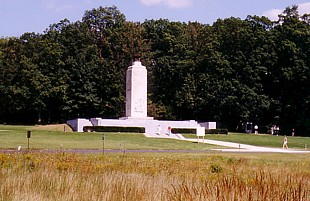
|
| Gettysburg NMP |
Hicks and other survivors were herded to the rear as more troops rushed
into the field. Despite efforts to get support to his trapped regiments, General Iverson was helpless to stop the destruction
of his command. He had made the error of not scouting the ground in front of his brigade nor had he gone in with them to provide
orders and extract them from the trap. The general reported afterward that "no greater gallantry and heroism has been displayed
during this war."
Only General Junius Daniel's North Carolina Brigade was successful in bypassing
the disaster that befell Iverson's men, and engaged in the fighting near the railroad bed and McPherson Farm. Confederate
batteries on Oak Hill renewed their fire on the Union positions while General Rodes reorganized his troops for another effort,
sending forward his reserve brigade to strike Oak Ridge and support Daniel's men. Outnumbered and out of ammunition, Union
troops eventually abandoned Oak Ridge, allowing Rodes' troops to push southward toward the Seminary and Gettysburg. By 5 PM,
Oak Hill had been abandoned for more favorable positions on Oak Ridge.
| Eternal Light Peace Memorial Dedication |
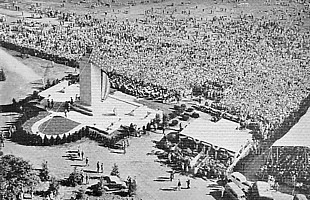
|
| July 3, 1938 (Gettysburg NMP) |
Located on the summit of Oak Hill and surrounded by guns that mark Confederate artillery positions,
the Eternal Light Peace Memorial overlooks the July 1st battlefield. The memorial was the sentimental brainchild of Union
and Confederate veterans who first proposed the monument during the 1913 Anniversary and reunion celebration at Gettysburg.
Funds for the project were difficult to find and the Great Depression postponed its construction. Through the personal efforts
of governors, veteran groups and several state legislatures, the memorial project was revived and finally came to fruition.
It was a torridly hot afternoon on July 3, 1938, when former Union and Confederate soldiers met
to dedicate this memorial to "Peace Eternal in a Nation United" during the 75th Anniversary Celebration of the battle. A Union
and a Confederate veteran pulled the ropes to unveil the memorial shaft that towers 47 1/2 feet above Oak Hill. President
Franklin Delano Roosevelt was the featured speaker at the ceremony and pushed the button which lit the gas flame on top of
the monument shaft. "Immortal deeds and immortal words have created here at Gettysburg a shrine of American patriotism," the
president began. "We are encompassed by 'the last full measure' of many men and by the simple words in which Abraham Lincoln
expressed the simple faith for which they died." The president went on to compare the task set before Lincoln and the American
people in 1863, with the task set before Americans in 1938. Of the veterans in blue and gray, Roosevelt reminded the audience,
"All of them we honor, not asking under which Flag they fought then- thankful that they
stand together under one Flag now." (Also see: The Great Gettysburg Reunion of 1913 and Last Great Gettysburg Reunion of 1938.)
| President Roosevelt at dedication in 1938 |
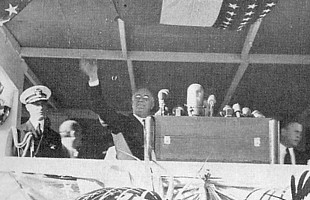
|
| Gettysburg NMP |
Pennsylvania State Police estimated that 250,000 people attended the dedication while another 100,000 remained
stuck on automobile-packed highways.
The memorial cost $60,000 with contributions from many states including New York, Pennsylvania, Tennessee
and Virginia. The dark colored stone base was constructed of Maine granite and the lighter colored shaft of Alabama Rockwood
Limestone. The memorial has undergone two restoration projects since its construction, the last in 1988 when the gas flame
was restored and the monument rededicated with an appropriate ceremony that featured Dr. Carl Sagan as the keynote speaker.
Except for a period during the energy crisis of the mid-1970's followed by a nine-year span when it was electrified, the gas-fueled
flame has burned continuously twenty four hours a day.
The dedication of the memorial by President Roosevelt was the highlight of four days of activities commemorating
the 75th Anniversary of the battle and hosted by the Commonwealth of Pennsylvania. More than 1,800 aged Civil War veterans
attended the last great reunion, much of which took place on the Gettysburg College campus. Veterans were housed in white
canvas tent camps erected in the fields north of the college, each camp having wooden boardwalks, electric lights, and large
mess tents for food service. Parades and military demonstrations by the United States Army featured mounted cavalry charges,
infantry demonstrations, and a display of army tanks and vehicles.
Source: National Park Service; Gettysburg National Military Park
Recommended Reading: Gettysburg--The First Day, by Harry W. Pfanz (Civil War America) (Hardcover). Description: Though a great deal has been written about the battle of Gettysburg,
much of it has focused on the events of the second and third days. With this book, the first day's fighting finally receives
its due. Harry Pfanz, a former historian at Gettysburg National Military Park
and author of two previous books on the battle, presents a deeply researched, definitive account of the events of July 1,
1863.
After sketching the background
of the Gettysburg
campaign and recounting the events immediately preceding the battle, Pfanz offers a detailed tactical description of the first
day's fighting. He describes the engagements in McPherson Woods, at the Railroad Cuts, on Oak
Ridge, on Seminary Ridge, and at Blocher's Knoll, as well as the retreat of Union forces through Gettysburg and the Federal rally on Cemetery Hill. Throughout, he draws on
deep research in published and archival sources to challenge some of the common assumptions about the battle--for example,
that Richard Ewell's failure to press an attack against Union troops at Cemetery Hill late on the first day ultimately cost
the Confederacy the battle.
Recommended Reading: Gettysburg:
A Testing of Courage. Description: America's
Civil War raged for more than four years, but it is the three days of fighting in the Pennsylvania
countryside in July 1863 that continues to fascinate, appall, and inspire new generations with its unparalleled saga of sacrifice
and courage. From Chancellorsville, where General Robert E. Lee launched his high-risk campaign into the North, to the Confederates'
last daring and ultimately-doomed act, forever known as Pickett's Charge, the battle of Gettysburg gave the Union army a victory
that turned back the boldest and perhaps greatest chance for a Southern nation. Continued below...
Now, acclaimed
historian Noah Andre Trudeau brings the most up-to-date research available to a brilliant, sweeping, and comprehensive history
of the battle of Gettysburg that sheds fresh light on virtually every aspect of it. Deftly balancing his own
narrative style with revealing firsthand accounts, Trudeau brings this engrossing human tale to life as never before.
Recommended
Reading:
The Artillery of Gettysburg (Hardcover). Description:
The battle of Gettysburg in July 1863, the apex of the Confederacy's
final major invasion of the North, was a devastating defeat that also marked the end of the South's offensive strategy against
the North. From this battle until the end of the war, the Confederate armies largely remained defensive. The Artillery of
Gettysburg is a thought-provoking look at the role of the artillery during the July 1-3, 1863 conflict. Continued below...
During the
Gettysburg
campaign, artillery had already gained the respect in both armies. Used defensively, it could break up attacking formations
and change the outcomes of battle. On the offense, it could soften up enemy positions prior to attack. And even if the results
were not immediately obvious, the psychological effects to strong artillery support could bolster the infantry and discourage
the enemy. Ultimately, infantry and artillery branches became codependent, for the artillery needed infantry support lest
it be decimated by enemy infantry or captured. The Confederate Army of Northern Virginia had modified its codependent command
system in February 1863. Prior to that, batteries were allocated to brigades, but now they were assigned to each infantry
division, thus decentralizing its command structure and making it more difficult for Gen. Robert E. Lee and his artillery
chief, Brig. Gen. William Pendleton, to control their deployment on the battlefield. The Union Army of the Potomac
had superior artillery capabilities in numerous ways. At Gettysburg,
the Federal artillery had 372 cannons and the Confederates 283. To make matters worse, the Confederate artillery frequently
was hindered by the quality of the fuses, which caused the shells to explode too early, too late, or not at all. When combined
with a command structure that gave Union Brig. Gen. Henry Hunt more direct control--than his Southern counterpart had over
his forces--the Federal army enjoyed a decided advantage in the countryside around Gettysburg. Bradley
M. Gottfried provides insight into how the two armies employed their artillery, how the different kinds of weapons functioned
in battle, and the strategies for using each of them. He shows how artillery affected the “ebb and flow” of battle
for both armies and thus provides a unique way of understanding the strategies of the Federal and Union
commanders.
Recommended Reading: ONE CONTINUOUS FIGHT: The Retreat from Gettysburg and the Pursuit of Lee's Army of Northern Virginia, July
4-14, 1863 (Hardcover) (June 2008). Description: The titanic three-day battle of Gettysburg
left 50,000 casualties in its wake, a battered Southern army far from its base of supplies, and a rich historiographic legacy.
Thousands of books and articles cover nearly every aspect of the battle, but not a single volume focuses on the military aspects
of the monumentally important movements of the armies to and across the Potomac River. One
Continuous Fight: The Retreat from Gettysburg and the Pursuit
of Lee's Army of Northern Virginia, July 4-14, 1863 is the first detailed military history of Lee's retreat and the Union
effort to catch and destroy the wounded Army of Northern Virginia. Against steep odds and encumbered with thousands of casualties,
Confederate commander Robert E. Lee's post-battle task was to successfully withdraw his army across the Potomac River. Union
commander George G. Meade's equally difficult assignment was to intercept the effort and destroy his enemy. The responsibility
for defending the exposed Southern columns belonged to cavalry chieftain James Ewell Brown (JEB) Stuart. If Stuart fumbled
his famous ride north to Gettysburg, his generalship during
the retreat more than redeemed his flagging reputation. The ten days of retreat triggered nearly two dozen skirmishes and
major engagements, including fighting at Granite Hill, Monterey Pass,
Hagerstown, Williamsport, Funkstown,
Boonsboro, and Falling Waters. Continued
below...
President Abraham
Lincoln was thankful for the early July battlefield victory, but disappointed that General Meade was unable to surround and
crush the Confederates before they found safety on the far side of the Potomac. Exactly what Meade did to try to intercept the fleeing Confederates, and how the
Southerners managed to defend their army and ponderous 17-mile long wagon train of wounded until crossing into western Virginia on the early morning of July 14, is the subject of this study.
One Continuous Fight draws upon a massive array of documents, letters, diaries, newspaper accounts, and published primary
and secondary sources. These long-ignored foundational sources allow the authors, each widely known for their expertise in
Civil War cavalry operations, to describe carefully each engagement. The result is a rich and comprehensive study loaded with
incisive tactical commentary, new perspectives on the strategic role of the Southern and Northern cavalry, and fresh insights
on every engagement, large and small, fought during the retreat. The retreat from Gettysburg
was so punctuated with fighting that a soldier felt compelled to describe it as "One Continuous Fight." Until now, few students
fully realized the accuracy of that description. Complimented with 18 original maps, dozens of photos, and a complete driving
tour with GPS coordinates of the entire retreat, One Continuous Fight is an essential book for every student of the American
Civil War in general, and for the student of Gettysburg in
particular. About the Authors: Eric J. Wittenberg has written widely on Civil War cavalry operations. His books include Glory
Enough for All (2002), The Union Cavalry Comes of Age (2003), and The Battle of Monroe's Crossroads and the Civil War's Final
Campaign (2005). He lives in Columbus, Ohio.
J. David Petruzzi is the author of several magazine articles on Eastern Theater cavalry operations, conducts tours of cavalry
sites of the Gettysburg Campaign, and is the author of the popular "Buford's Boys." A long time student of the Gettysburg
Campaign, Michael Nugent is a retired US Army Armored Cavalry Officer and the descendant of a Civil War Cavalry soldier. He
has previously written for several military publications. Nugent lives in Wells, Maine.
Recommended Reading:
General Lee's Army: From Victory to Collapse. Review:
You cannot say that University of North
Carolina professor Glatthaar (Partners in Command) did not do his homework in this massive examination
of the Civil War–era lives of the men in Robert E. Lee's Army of Northern Virginia. Glatthaar spent nearly 20 years
examining and ordering primary source material to ferret out why Lee's men fought, how they lived during the war, how they
came close to winning, and why they lost. Glatthaar marshals convincing evidence to challenge the often-expressed notion that
the war in the South was a rich man's war and a poor man's fight and that support for slavery was concentrated among the Southern
upper class. Continued below...
Lee's army
included the rich, poor and middle-class, according to the author, who contends that there was broad support for the war in
all economic strata of Confederate society. He also challenges the myth that because Union forces outnumbered and materially
outmatched the Confederates, the rebel cause was lost, and articulates Lee and his army's acumen and achievements in the face
of this overwhelming opposition. This well-written work provides much food for thought for all Civil War buffs.
Recommended Reading: The History
Buff's Guide to Gettysburg (Key People, Places, and Events)
(Key People, Places, and Events). Description: While most history books are dry monologues of people, places, events and dates,
The History Buff's Guide is ingeniously written and full of not only first-person accounts but crafty prose. For example,
in introducing the major commanders, the authors basically call Confederate Lt. Gen. Richard S. Ewell a chicken literally.
Continued
below...
'Bald, bug-eyed,
beak-nosed Dick Stoddard Ewell had all the aesthetic charm of a flightless foul.' To balance things back out a few pages later,
they say federal Maj. Gen. George Gordon Meade looked like a 'brooding gargoyle with an intense cold stare, an image in perfect
step with his nature.' Although it's called a guide to Gettysburg, in my opinion, it's an authoritative guide to
the Civil War. Any history buff or Civil War enthusiast or even that casual reader should pick it up.
Recommended Reading: Hallowed Ground: A Walk at Gettysburg,
by James M. Mcpherson (Crown Journeys) (Hardcover). Review From Publishers Weekly: The country's most distinguished Civil War historian, a Pulitzer Prize winner (for
Battle Cry of Freedom) and professor at Princeton, offers this compact and incisive study
of the Battle of Gettysburg. In narrating "the largest battle ever fought in the Western Hemisphere,"
McPherson walks readers over its presently hallowed ground, with monuments numbering into the hundreds, many of which work
to structure the narrative. Continued below...
They range
from the equestrian monument to Union general John Reynolds to Amos Humiston, a New Yorker identified several months after
the battle when family daguerreotypes found on his body were recognized by his widow. Indeed, while McPherson does the expected
fine job of narrating the battle, in a manner suitable for the almost complete tyro in military history, he also skillfully
hands out kudos and criticism each time he comes to a memorial. He praises Joshua Chamberlain and the 20th Maine, but also the 140th New York
and its colonel, who died leading his regiment on the other Union flank in an equally desperate action. The cover is effective
and moving: the quiet clean battlefield park above, the strewn bodies below. The author's knack for knocking myths on the
head without jargon or insult is on display throughout: he gently points out that North Carolinians think that their General
Pettigrew ought to share credit for Pickett's charge; that General Lee's possible illness is no excuse for the butchery that
charge led to; that African-Americans were left out of the veterans' reunions; and that the kidnapping of African-Americans
by the Confederates has been excised from most history books.
Recommended Reading: Gettysburg, by Stephen
W. Sears (640 pages) (November 3, 2004). Description: Sears
delivers another masterpiece with this comprehensive study of America’s
most studied Civil War battle. Beginning with Lee's meeting with Davis in May 1863, where he
argued in favor of marching north, to take pressure off both Vicksburg
and Confederate logistics. It ends with the battered Army of Northern Virginia re-crossing the Potomac just two months later
and with Meade unwilling to drive his equally battered Army of the Potomac into a desperate
pursuit. In between is the balanced, clear and detailed story of how tens-of-thousands of men became casualties, and how Confederate
independence on that battlefield was put forever out of reach. The author is fair and balanced. Continued below...
He discusses
the shortcomings of Dan Sickles, who advanced against orders on the second day; Oliver Howard, whose Corps broke and was routed
on the first day; and Richard Ewell, who decided not to take Culp's Hill on the first night, when that might have been decisive.
Sears also makes a strong argument that Lee was not fully in control of his army on the march or in the battle, a view conceived
in his gripping narrative of Pickett's Charge, which makes many aspects of that nightmare much clearer than previous studies.
A must have for the Civil War buff and anyone remotely interested in American history.
|

